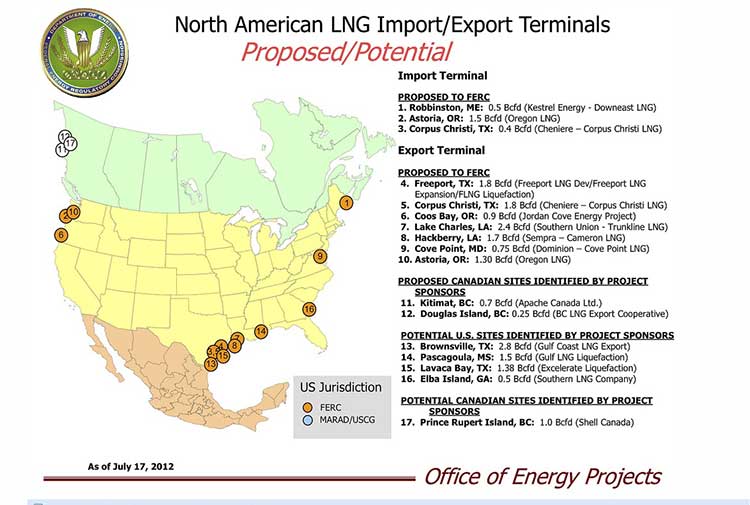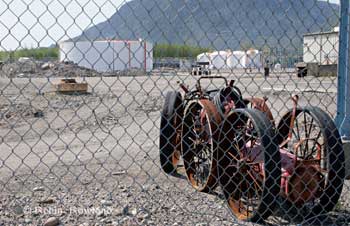 Apache has a new partner in the Kitimat LNG project, Chevron Canada Ltd and, in effect, Chevron is taking over the project from Apache who has been unable to find customers for the liquified natural gas project in Asia.
Apache has a new partner in the Kitimat LNG project, Chevron Canada Ltd and, in effect, Chevron is taking over the project from Apache who has been unable to find customers for the liquified natural gas project in Asia.
A news release from Apache announced “a broad agreement with Chevron Canada Limited to build and operate the Kitimat LNG project.”
Chevron Canada and Apache Canada each will become a 50 per cent owner of the Kitimat LNG plant, the Pacific Trail Pipeline and 644,000 gross undeveloped acres in the Horn River and Liard basins. Chevron Canada will operate the LNG plant, which will be located on the northern British Columbia coast, and the pipeline. Apache will continue to develop shale gas resources at the Liard and Horn River basins in north eastern BC.
Encana and EOG Resources — currently 30 percent non-operating partners in Kitimat LNG and Pacific Trail Pipeline — will sell their interests to Chevron and exit the venture. As part of the transaction with Chevron, Apache will increase its ownership of the plant and pipeline to 50 percent from 40 percent.
G. Steven Farris, Apache’s chairman and chief executive officer said in the company news release, “This agreement is a milestone for two principal reasons: Chevron is the premier LNG developer in the world today with longstanding relationships in key Asian markets, and the new structure will enable Apache to unlock the tremendous potential at Liard, one of the most prolific shale gas basins in North America.” “With experience developing LNG projects, marketing expertise and financial wherewithal, Chevron is the preferred coventurer to join Kitimat LNG,” Farris said. “Apache has a proven record in finding and developing shale gas resources in Canada and is the logical operator for the upstream elements of the joint venture.”
In its news release, Chevron quoted vice chairman George Kirkland as saying: “The Kitimat LNG development is an attractive opportunity that is aligned with existing strategies and will drive additional long-term production growth and shareholder returns.”
“This investment grows our global LNG portfolio and builds upon our LNG construction, operations and marketing capabilities. It is ideally situated to meet rapidly growing demand for reliable, secure, and cleaner-burning fuels in Asia, which are projected to approximately double from current levels by 2025.”
The two-train (stage) Kitimat LNG Project is still working through the Front-End Engineering and Design (FEED) phase. Construction has continued at the Bish Cove site throughout the summer but has slowed down to the uncertainty over the future of the project and some environmental problems.
Current plans call for two liquefaction trains, each with expected capacity of 5 million tons of LNG per annum (about 750 million cubic feet of gas per day). Kitimat has received all significant environmental approvals and a 20-year export license from the Canadian federal government.
The 290-mile (463-km) Pacific Trail Pipeline is planned to provide a direct connection between the Spectra Energy Transmission pipeline system and the Kitimat LNG terminal.
While the Apache release says: “The project has strong support from many of the First Nations along the route,” there is no support at this moment from the Wet’suwet’en, in the area from Burns Lake through Smithers to the mountains, because some houses are strongly opposed to the pipeline on their traditional territory.
In the Apache news release, Farris says: “”We want to thank and acknowledge EOG and Encana for their contribution to the development of the Kitimat project. We appreciate the hard work of many employees and contractors to advance the project to this stage and the strong support the plant and pipeline projects have received from local communities, provincial and federal officials and the Haisla and other First Nations.
“Construction of the plant and pipeline will have a significant economic impact, and the operational phase will provide opportunities for employment as well as royalties and tax revenues for the Federal, Provincial and local governments for many years,” he said. “Chevron and Apache will continue to develop this project in a safe and environmentally responsible manner.”
As the news releases point out Chevron is a major player in Australia’s LNG projects, considered by many to be Canada’s rival in finding market for natural gas in Asia. Chevron is the operator and led marketing efforts at Wheatstone, a two-train plant with capacity of 8.9 million tons of LNG a year that is expected to commence operations in 2016. Chevron also operates the Gorgon LNG project in Australia and LNG Angola.
Much of the media attention is also on the deal for the natural resources northeastern BC, with, Chevron Canada acquiring approximately 110,000 net acres in the established Horn River Basin from Encana, EOG and Apache, and approximately 212,000 net acres in the Liard Basin from Apache. Chevron Canada Limited and Apache will each hold a 50 percent interest and Apache will operate these two natural gas resource developments.
In its news release, Encana concentrates on the natural gas deal, quoting Randy Eresman, Encana’s President & CEO, “This investment by Chevron, a multinational LNG player, represents a key step in the development of LNG export from Western Canada. Our main goal since we first acquired an interest in Kitimat LNG almost two years ago was to help ensure the progression of this project towards its development. While we are no longer a direct participant in this project, we continue to support LNG export as vital to diversifying markets for North American natural gas.”
The company goes on to say that: “The sale of Encana’s interest in the proposed Kitimat LNG export facility is consistent with the company choosing to focus on its core business. In addition, this transaction reduces Encana’s future capital commitments. The proceeds from this transaction will help to strengthen the balance sheet and provide further financial flexibility to fund capital programs and develop key and emerging resource plays.”
The Financial Post points out that “the Chevron deal leaves most of the LNG projects in the hands of foreign companies, which have competing interests in LNG projects across the world.” That means that the Haisla Nation, with its partnership with the BC LNG project, is one of the few Canadian players left in the LNG scramble.






